
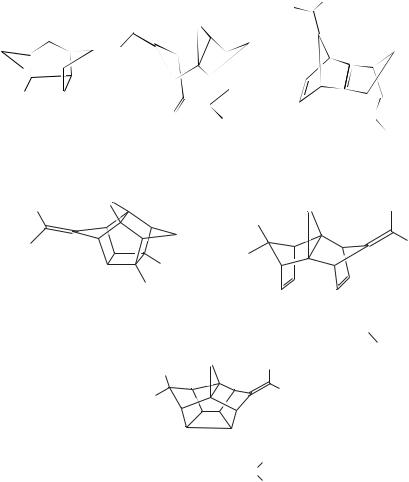
4. Photochemistry of non-conjugated dienes |
287 |
adduct 201, formed by epoxidation of the air-sensitive adduct 202, affords |
the cage |
compound 203 when acetone-sensitization is employed93. Triplet-sensitized irradiation (350 nm) in acetone of the triene 204a and the tetraene 204b affords the cage compounds
205 in 32% yield94,95.
Me |
Me |
|
O
|
Me |
|
|
|
R1 |
|
|
CO2Me |
|
|
CO2Me |
|
(203) |
(204) (a) |
|
|
(204) (b) |
|
|
CO2Me |
|
|
CO2Me |
(200) |
|
(201) |
Me |
O |
O |
|
|
R |
Me |
|
|
Me
 CO2Me
CO2Me
CO2Me
(202)
Me
Me
R = R1 = H
Me
R R = 


Me
R
R1
(205) (a)
(205) (b)
O Me
Me
R = R1 = H
Me
RR = 
 C
C
Me
Cycloaddition is also observed on irradiation of the diene 206 to yield the adduct 207. This product can be hydrolysed and decarboxylated to afford the corresponding azo compound96. The adduct 208 is photochemically converted into the cage compound 209 in 38% yield on irradiation at 254 nm97.
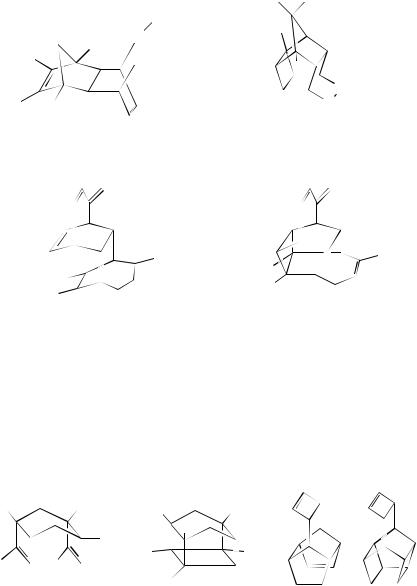
288 |
|
|
|
William M. Horspool |
|
|
|
|
|
|
|
|
|
|
MeO |
OMe |
|||
MeO |
OMe |
|
|
CO2Et |
Cl |
||||
|
|
|
Cl |
|
|
|
|
||
|
Cl |
N |
|
|
|
|
|||
Cl |
|
|
|
|
|
|
|
|
|
|
N |
|
CO2Et |
Cl |
|||||
|
|
||||||||
|
|
|
|
|
Cl |
||||
|
|
|
|
|
|
|
N |
|
CO2Et |
|
|
|
|
|
|
|
|||
Cl Cl |
|
|
|
|
|
N |
|||
|
|
|
|
|
|
|
|
|
|
|
|
|
|
|
|
CO2Et |
|||
|
(206) |
|
|
|
|
(207) |
|
|
|
|
O |
|
|
|
|
|
O |
||
|
|
|
|
CN |
|
|
|
CN |
|
|
|
|
|
|
MeO2C |
|
|
|
|
MeO2C |
CO2Me |
|
MeO2C |
||
(209) |
||
|
||
|
(208) |
7. Miscellaneous cycloadditions
Irradiation of the bis-alkene 210 brings about the formation of the bishomocubane 211 in good yield98. The triene 212 is of interest and has been shown to be photochemically reactive, yielding the adduct 213 on irradiation. Several approaches to 212 have been reported over the years. One such approach follows the path of photocyclization of 214 to yield 215 that can be converted to the desired product 21299. A variety of sensitizers can be used for the excitation of alkenes to bring about the (2 C 2)-cycloaddition. Commonly, acetone has been used but, in at least one case, the formation of the cage compound 216 from the diene 217, tetraphenylporphine has been found to be of use100.
Me |
Me |
Me |
|
|
|
Me |
|
||
|
|
|
|
|
|
||||
|
Me |
|
Me |
Me |
|
||||
|
Me |
|
|
|
|
|
|||
|
|
|
|
|
|
|
|
|
|
Me |
Me |
Me |
|
|
|
Me |
|
||
|
|
|
|
||||||
|
|
|
|
||||||
|
|
|
|
|
|
|
|
||
|
Me |
Me |
|
|
|
Me |
|
|
|
|
|
|
|
|
|
||||
|
Me |
|
|
|
|
|
|
|
|
|
(210) |
|
(211) |
(212) |
(213) |
||||

4. Photochemistry of non-conjugated dienes |
289 |
|
O |
|
|
O |
|
|
||
O |
O |
|
(215) |
||
(214) |
||
|
(216) |
(217) |
The approach to highly complex cage systems is not always straightforward. Thus while (2 C 2)-cycloaddition within 218 readily affords 219, the more highly strained diene 220 fails to cyclize upon irradiation101. Previously, it has been mentioned that Prinzbach and his coworkers77 have synthesized a variety of complex structures using a photochemical (2 C 2)-cycloaddition as a key step in the approach. Another complex structure, the isopagodane, has also been synthesized. One of the approaches leading to these compounds involves a double (2 C 2)-photocycloaddition. Thus irradiation in benzene solution brings about the formation of 221 from 222. Cycloaddition is also possible in 221 and this yields 223102. Cycloaddition by acetone-sensitized irradiation also brings about the ring closure of the diene 224. This yields the heptacyclic product 225 that is a key intermediate in the synthesis of bishomohexaprismane molecule 226103,104.
OMe |
Cl Cl OMe |
|
|
|
Cl Cl |
Cl |
OAc |
||
OMe |
OMe |
|||
Cl |
|
|||
|
|
|
||
Cl Cl |
Cl Cl |
|
Cl Cl |
|
(218) |
(219) |
|
(220) |
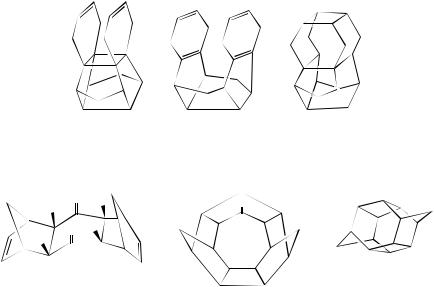
290 |
William M. Horspool |
|
(221) |
(222) |
(223) |
|
|
|
|
O |
|
O |
H |
|
|
|
|
O |
|||
H |
|
|
|
|
O H
H
(224) |
(225) |
(226) |
IV. CYCLIZATION OF NORBORNADIENES AND RELATED COMPOUNDS
A. All Carbon Systems
One of the areas that has been studied in considerable detail is that of the cyclization reaction of norbornadiene to quadricyclane that can be brought about either by direct or by sensitized irradiation. This was first reported by Cristol and Snell105 and soon became an area of interest to others106,107. Since these early investigations where much of the work focused on the homoconjugation of the system, a great deal of research has been carried out and a good understanding of the processes involved has now been acquired. Much of this earlier work has appeared in most textbooks devoted to photochemistry and, in addition, most of the standard textbooks and monographs on the subject now have details of these reactions. Since this is the case the present section will highlight what has been achieved in the last decade or so.
As mentioned above, the ring closure of norbornadiene to quadricyclane can be brought about by sensitization. Interest in this area has shown that tetraphenylporphine can be a useful sensitizer for the conversion of norbornadiene into quadricyclane108. Part of this research is associated with energy storage systems and several copper(I)-based photosensitizers have been synthesized in an attempt to improve the norbornadiene/quadricyclane solar energy storage system 109. In this respect, also, Yang and coworkers110 have reported that the conversion of quadricyclane back into norbornadiene can be sensitized by dibenzoylmethanatoboron difluoride.
Interest in intramolecular energy transfer has also been reported and bichromophoric norbornadiene derivatives have been synthesized for this study111. Cao and coworkers112
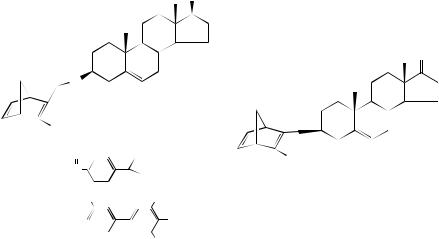
4. Photochemistry of non-conjugated dienes |
291 |
report that intramolecular triplet energy transfer from the benzophenone |
moiety to |
the norbornadiene unit in 227 takes place with a rate constant of 6.1 ð 104 s 1. The bichromophoric system 228 undergoes intramolecular electron transfer by a through-bond mechanism on irradiation. The transfer is from the benzidine moiety to the norbornadiene moiety and occurs with 12% efficiency. The ultimate intermediate is the triplet radical ion pair113. Irradiation ( > 300 nm) of the norbornadiene derivative 229 results in excitation of the androstene carbonyl group. Apparently, this affords the triplet excited state that transfers triplet energy by a through-bond mechanism to the norbornadiene. This undergoes cyclization to the corresponding quadricyclane. The energy transfer occurs with 18.6% efficiency114. Calculations have dealt with the energetics of the photoisomerization within the norbornadiene/quadricyclane system115. Constrained environments have also been of interest in a number of areas and norbornadiene cyclization has not been excluded. Thus, a study of the photoisomerization of some norbornadienes has been carried out within the constrained environment of ˇ-cyclodextrin116.
R
O
O
|
|
O |
|
|
|
|
|||
CO2Me |
|
|
|
|
|||||
|
|
O |
O |
|
CO2Me |
||||
(227) R = OC |
|
|
|
||||||
|
|
Ph |
|||||||
|
|
|
|
|
|
|
|
||
|
|
|
|
|
|
|
|
(229) |
|
|
Me Me |
|
|
|
Me |
||||
|
|
|
|
|
|
|
|
|
|
(228) R = N |
|
|
|
|
|
|
NMe2 |
||
|
|
|
|||||||
|
|
|
Me |
|
|
|
Me |
||
The simple systems such as 230 are also of interest. These readily undergo cyclization to the quadricyclanes 231 in good yield. The principal reason for the study of these systems was an attempt to obtain energy storage molecules. Thus the reverse reaction is important and the quadricyclanes 231 can undergo ring-opening when treated with silver ion117. If the use of the norbornadiene/quadricyclane as energy storage systems is to be exploited, systems have to be devised that can be cyclized using sunlight. This is the case with the water-soluble norbornadiene 232 which is efficiently converted into the corresponding quadricyclane on irradiation with sunlight118. Other norbornadienes with carboxylic acid functional groups, e.g. 233, also undergo efficient cyclization to 234119 as does 235 into 236 in a yield of 75%120. The photochemical formation of the quadricyclanes 237 by acetophenone-sensitized irradiation of 238 has been reported. The quadricyclanes were used as substrates in an approach to the synthesis of 1,5-dehydroquadricyclane121.
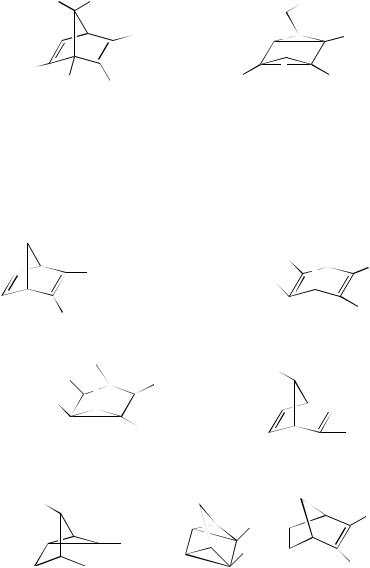
292 |
|
|
|
|
|
William M. Horspool |
|
|
|
|
||
R3 |
|
R4 |
|
|
R3 |
|
|
|
R4 |
|||
R2 |
|
|
|
CO2Me |
R2 |
|
|
|
|
CO2Me |
||
|
|
|
|
|
|
|||||||
|
|
|
|
|
|
|
|
CO2Me |
||||
|
R1 |
|
|
CO2Me |
R1 |
|
||||||
|
|
|
|
|
|
|||||||
|
|
|
(230) |
R1 = R2 = R3 = R4 = H |
|
(231) |
||||||
|
|
|
|
|
|
R1 = Me, |
R2 = R3 = R4 = H |
|
|
|
|
|
|
|
|
|
|
|
R2 = Me, |
R1 = R3 = R4 = H |
|
|
|
|
|
|
|
|
|
|
|
R3 = Me, |
R1 = R2 = R4 = H |
|
|
|
|
|
|
|
|
|
|
|
R4 = Me, |
R1 = R2 = R3 = H |
|
|
|
|
|
|
|
|
|
|
|
R1 = R2 = H, R3 = R4 = Me. |
|
|
|
|
||
|
|
|
|
|
|
+ |
|
HO2C |
|
CO2H |
||
|
|
|
|
|
|
|
|
|
|
|
||
|
|
|
CONHCH2 CH2NHMe2 |
HO2C |
|
|
|
|
||||
|
|
|
|
|
|
|
|
|
|
|
|
|
|
COO− |
|
|
|
|
|
|
CO2H |
||||
|
|
|
|
|
|
|
|
|||||
|
|
|
(232) |
|
|
|
|
|
(233) |
|||
HO2C |
|
|
|
CO2H |
|
O2N |
|
|
|
|
||
|
|
|
|
|
|
|
|
|
||||
|
|
|
|
|
|
|
|
|
|
|
|
|
HO2C |
|
|
|
|
|
|
|
|
|
CO2Me |
||
|
|
|
|
|
|
|
|
|
||||
|
|
|
|
|
|
|
|
|
||||
|
|
|
|
|
|
|
|
|
|
|
|
|
|
|
|
|
|
|
CO2H |
|
|
|
|
|
CO2Me |
|
|
|
(234) |
|
|
|
|
|
(235) |
|||
O2N |
|
|
|
|
|
|
|
|
|
R1 |
||
|
|
|
|
|
|
|
|
R1 |
|
|
|
|
|
|
|
|
|
|
|
|
|
|
|
|
|
|
|
|
|
|
|
CO2Me |
|
R2 |
|
|
|
R2 |
|
|
|
|
|
|
|
|
|
|
|||
|
|
|
|
|
|
CO2Me |
|
|
|
|
|
|
(236) |
|
|
|
|
(237) |
|
|
|
(238) |
|||
|
|
|
|
|
|
|
R1 = Br, R2 = Br or Cl |
|||||
The variety of derivatives that undergoes cyclization is almost limitless, as shown by the conversion of 239 into 240. Here, one of the functional groups on the norbornadiene is ketonic122. The isomerization of other keto or aldehydo derivatives of norbornadiene into
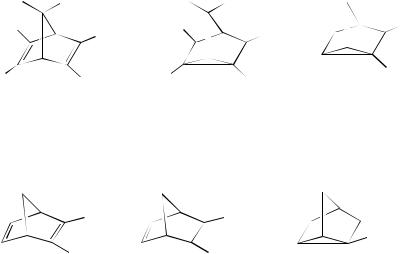
|
|
|
|
|
|
|
4. Photochemistry of non-conjugated dienes |
293 |
||||||||||||||
R3 |
|
|
R4 |
|
|
|
R3 |
|
|
|
R4 |
|
|
|
|
|
|
|
|
|||
R2 |
|
|
|
|
|
COBu-n |
R2 |
|
|
|
|
|
COBu-n |
|
|
|
Ph |
|||||
|
|
|
|
|
|
|
|
|
|
|
|
|
|
|
|
CH |
|
X |
||||
|
|
|
|
|
|
|
|
|
|
|
|
|
|
|
|
|
||||||
R1 |
|
|
R |
5 |
|
R1 |
|
|
|
|
|
R |
5 |
|
|
|
|
|
||||
|
|
|
|
|
|
|
|
|
|
|
|
|
||||||||||
|
|
|
|
|
|
|
|
|
|
|
|
|||||||||||
|
|
|
|
|
|
|
|
|
|
|
|
|||||||||||
|
|
|
|
|
|
|
|
|
|
|
|
|
|
|
|
|
|
|
|
|||
|
|
(239) |
|
|
|
|
|
|
(240) |
|
|
|
|
(241) |
|
|
||||||
R1 |
|
|
R4 = H or Me |
|
|
|
|
|
|
|
|
|
|
(a) X = O |
||||||||
|
|
|
|
|
|
|
|
|
|
|
|
|||||||||||
R5 = CHFEt, CF2Et or CF3 |
|
|
|
|
|
|
|
|
(b) X = NPh |
|||||||||||||
|
|
|
|
|
|
|
|
|
|
|
|
|
|
|
|
|
(c) X = NC6H4OMe-p |
|||||
|
|
|
|
Ph |
|
|
|
|
Ph |
|
|
|
|
|
Ph |
|||||||
|
|
|
|
|
|
|
|
|
|
|
|
|
||||||||||
|
|
|
|
3 |
|
|
|
|
|
3 |
|
|
|
|
|
|
|
|
CONHR |
|||
|
|
|
|
|
|
|
|
|
|
|
|
|
|
|
|
|
|
|
|
|||
|
|
2 |
CH |
|
|
|
X |
2 |
|
CH |
|
C(CN)2 |
|
|
|
|
|
|
||||
|
|
|
|
|
|
|
|
|
|
|
|
|
|
|
|
|||||||
|
|
|
|
|
|
|
|
|
|
|
|
|
|
|
|
|||||||
(242) (a) X = O |
|
|
|
(243) |
|
|
|
|
|
(244) |
|
|
||||||||||
|
(b) X = NPh |
|
|
|
|
|
|
|
|
|
R = Ph, 1-Naphthyl, 2-Naphthyl |
|||||||||||
(c) X = NC6H4OMe-p
the corresponding quadricyclanes has also been reported123. Thus, the formation of the quadricyclane 241a occurs on irradiation of the phenyl-substituted norbornadiene 242a. The imines 241b and 241c are photoreactive under the same conditions. Again interest in these was centred on quadricyclanes as energy storage systems and copper(II) porphyrins rapidly brought about reformation of the photoreactive norbornadiene124. The imines 242b and 242c are also photoreactive124 as is 243125, and the corresponding quadricyclanes are formed on irradiation. The conversion of the norbornadienes 243 and 242b, has sought to examine structural effects. These derivatives showed a substantial lengthening of the C2 C3 double bond in comparison with unsubstituted derivatives. The authors125 observe that the quantum yield for the conversion of norbornadienes to quadricyclanes increases with shortening of the C2 C3 double bond. Efficiency of cyclization is also affected by changes in substitution as in the formation of the quadricyclanes 244 that can be obtained by irradiation of the norbornadienes 245 at 313 nm. The quantum yield for the cyclization, which can be as high as 0.71, can be enhanced by the change in substitution on the amide group126,127. Other studies have focused on the kinetics of the photochemical isomerization of the norbornadienes 246 into the corresponding quadricyclanes. The quantum yields for the processes were found to be in the range of 0.18 to 0.36. In these examples the authors128 suggest that the results are in agreement with the involvement of a radical cation mechanism (see earlier for examples of electron transfer processes applied to the norbornadiene system) in the cyclization. Others have studied the changes in efficiency of cyclization brought about by substituents on the aryl group in the conversion of the norbornadienes 247 into the quadricyclanes 248129. The yields shown under the products illustrate the qualitative effect on the overall yields of product. This is also the case in measurements of the quantum yields of the processes.
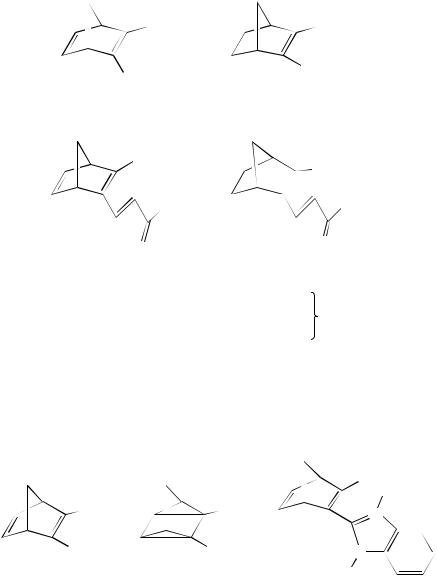
294 |
William M. Horspool |
|
|
Ph |
Ph |
|
CONHR |
CO2R |
|
|
|
(245) |
(246) |
|
|
R = H, PhCH2, p-MeOC6H4(CH2)n (n = 1, 6) |
|
|
Ph |
Ph |
|
|
|
|
Ar |
Ar |
(247) |
O |
O |
|
||
|
|
|
|
(248) |
yield (%) |
|
Ar = p-MeC6H4 |
40 |
|
Ar = p-ClC6H4 |
|
|
Ar = p-BrC6H4 |
96−100 |
|
Ar = m-O2NC6H4 |
|
Investigations have also examined the photochemical outcome of the inclusion of other aromatic substituents onto the norbornadienes. Examples of this are the direct and sensitized irradiation of the naphthyl-substituted derivatives 249 that brings about cyclization to 250. Sensitization of the cyclization with ketones such as benzophenone leads to a much cleaner reaction. Biacetyl has also been used as the sensitizer130,131. Cyclization also occurs with the norbornadiene 251132.
|
|
|
|
|
Ph |
Me |
|
|
|
|
|
|
|
|
CO2R1 |
|
|
CO2R1 |
N |
+ |
|
|
|
||||
|
|
|
||||
|
|
|
|
|
|
|
|
R2 |
|
|
R2 |
N |
|
(249) |
(250) |
Me |
|
|||
|
|
|
|
|
|
|
R1 = 1- or 2-naphthyl |
R1 = 1- or 2-naphthyl |
(251) |
|
|||
R2 = H or CO |
R1 |
R2 = H or CO R1 |
|
|||
|
|
|||||
2 |
|
2 |
|
|
||
The incorporation of sulphonyl groups does not inhibit the cyclization process as demonstrated by Gleiter and Ohlbach133, who have reported the efficient synthesis of the quadricyclane 252 by irradiation of the norbornadiene derivatives 253. A study has also been made of the sulphonyl-substituted norbornadiene derivatives 254134,135.
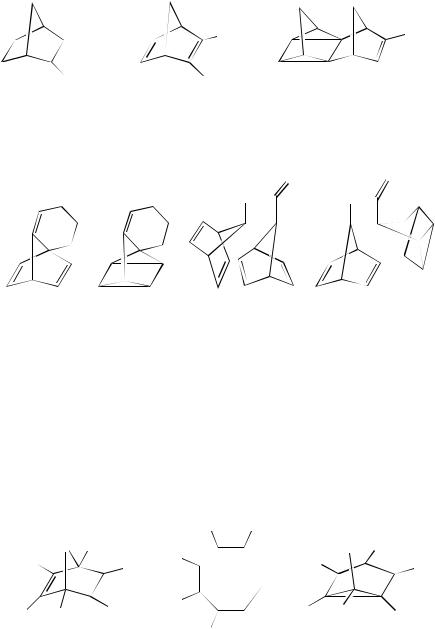
|
4. Photochemistry of non-conjugated dienes |
295 |
|
|
SO2Bu-t |
SO2Bu-t |
SO2Ph |
|
SO2Bu-t |
SO2Bu-t |
|
(252) |
(253) |
(254) |
|
Cyclizations have also been reported within strained systems such as the conversion of 255 to 256136 or the formation of 258 from 257137.
O O
HN HN
HN
(255) |
(256) |
(257) |
(258) |
B. Hetero Norbornadiene Systems
Like the cyclization of the parent system, the photocyclization of hetero analogues of norbornadiene was reported many years ago. Recent interest in this area will serve to illustrate the potential of the conversions. Thus the irradiation of the oxanorbornadiene system 259 brings about conversion to the oxepine 260138. The formation of 260 presumably arises by quadricyclane 261 formation, followed by secondary photolytic ring-opening. Other research has shown that irradiation of the oxanorbornadiene 262 follows the same reaction mode and it undergoes (2 C 2)-cycloaddition to the quadricyclane derivative 263. Apparently, in this instance, cycloreversion affords the ylide 264 that can be trapped by suitable addends, giving the adducts illustrated in Scheme 3139.
|
|
|
CF3 |
Et |
|
|
|
|
O |
Et |
|
|
O Et |
||
F3C |
|
F3C |
|
F3C |
|
|
|
|
CF3 |
|
|
|
CF3 |
||
|
|
|
|
O |
|
||
|
|
|
|
|
|
|
|
|
|
|
|
|
|
|
|
|
|
F3C |
|
F3C |
Et |
|
|
F3C |
Et |
CF3 |
CF3 |
||||
|
|
|
|
|
|||
|
(259) |
|
CF3 |
Et |
|
(261) |
|
(260)
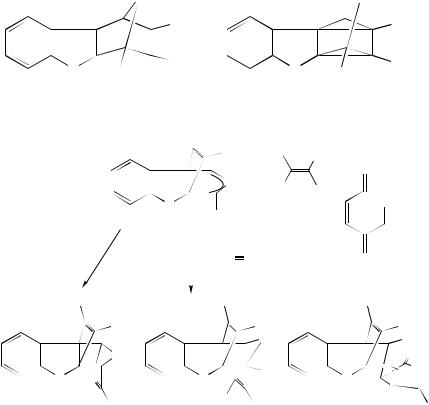
296 |
|
|
|
|
|
|
William M. Horspool |
|
|
|
|
|
|
||||
|
|
|
|
|
|
O |
|
|
|
|
|
|
|
O |
|
|
|
|
|
|
|
|
|
|
CO2Me |
|
|
|
|
CO2Me |
|||||
|
|
|
O |
|
|
|
CO2Me |
|
O |
|
|
CO |
Me |
||||
|
|
|
|
|
|
|
|
|
|||||||||
|
|
|
|
|
R |
|
|
|
|
|
R |
2 |
|
|
|
||
|
|
|
|
|
|
|
|
|
|
|
|
|
|
|
|
||
|
|
|
|
(262) |
|
|
|
|
|
(263) |
|
|
|
|
|||
|
|
|
|
|
|
|
|
CO2Me |
|
|
|
|
|
|
|
|
|
|
|
|
|
|
|
|
|
|
CO2Me |
CN |
|
|
|
|
|||
|
|
|
|
|
|
|
|
|
− O+ |
R = |
|
|
O |
|
|
|
|
|
|
|
|
|
|
|
|
|
t-Bu |
|
|
|
|
|
|
||
|
|
|
|
|
|
|
O |
|
|
|
|
NPh |
|
|
|
||
|
|
|
|
|
|
|
|
|
R |
|
|
|
|
|
|
|
|
|
|
|
|
|
|
CH3CN |
|
|
CH3O2CC |
CCO2CH3 |
|
|
O |
|
|
|
|
|
|
|
|
|
|
|
|
|
|
|
|
|
|
(264) |
|
|
|
|
|
|
CO2Me |
|
|
CO2Me |
|
|
CO2Me |
|
|
|
|||||
|
|
|
|
|
|
|
|
|
|
||||||||
|
|
|
|
|
|
CO2Me |
|
|
|
CO2Me |
|
|
CO2Me |
||||
|
|
|
|
|
|
|
|
|
|
O |
|
|
O |
|
|
|
|
|
|
|
|
|
|
O |
|
|
|
|
|
|
|
O |
|||
|
|
O |
|
N |
R |
|
|
O |
R |
|
O |
R |
|
NPh |
|||
|
|
|
|
|
|
|
|||||||||||
|
|
|
|
|
|
|
|
|
|
|
|
|
|||||
|
|
|
|
|
|
Me |
|
|
MeO2C |
CO2Me |
|
|
|
|
|
O |
|
|
|
|
|
|
|
|
|
|
|
|
|
|
|||||
|
|
|
|
|
|
|
|
|
|
|
|
|
|
||||
SCHEME 3
C. Prismanes
Benzenoid compounds on irradiation can be converted into the corresponding ‘Dewar’ benzene amongst other derivatives140. These Dewar derivatives, exemplified by 265, are also photochemically reactive and can undergo conversion into the corresponding prismane structure. This is probably the path followed on irradiation of the para-cyclophanes 266 at wavelengths greater than 270 nm. This yields the prismanes 267141. Gleiter and coworkers142,143 have also reported the photochemical behaviour of a number of benzene derivatives such as 268. Irradiation of this compound leads to the formation of the Dewar benzene 269 and the prismane 270. Isomers of 270 can also be formed by cyclization of the Dewar benzene derivatives 271a. Other examples, such as 271b, also cyclize efficiently, giving high yields of product. The irradiation of these derivatives uses a variety of wavelengths to achieve the cyclization. Structural proof for the prismanes formed by cyclization of 271c144 has been obtained by X-ray crystallography145. With the bis-system 272, the photo (2 C 2)-cycloaddition also occurs on irradiation at > 320 nm in ether. However, the initial prismane product undergoes a 1,5-hydrogen migration to yield 273 in 90% yield146.
